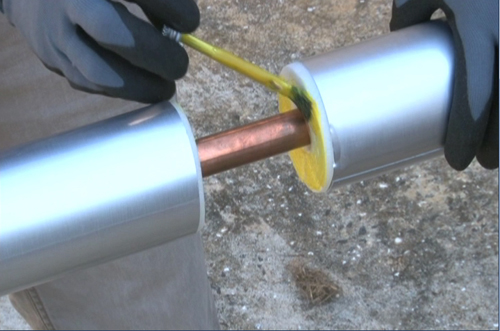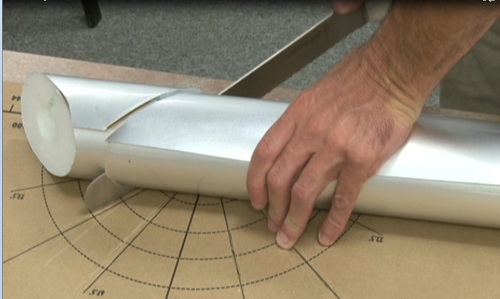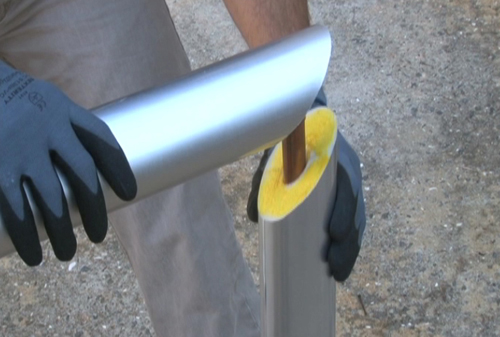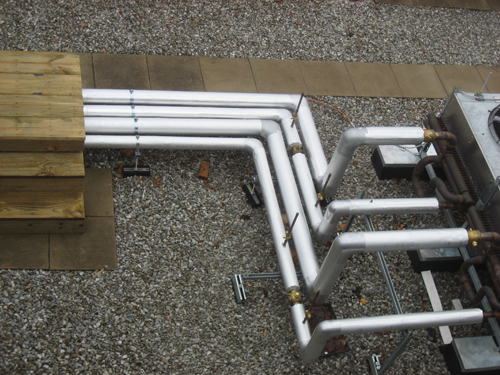Factory Jacketed Pipe Insulation for Outdoor Applications
Some types of thermal insulation materials, including polyolefin, flexible elastomeric, fiberglass, and calcium silicate, have become commercially available with factory-applied jacketing in an effort to increase productivity and improve material control and insulation system performance. Polystyrene, polyisocyanurate, and phenolic foam insulation materials are available with jacketing installed by a fabricator instead of a manufacturer, providing many of the same benefits of factory-applied jacketing.
Factory-applied jacketing types for outdoor use include coated aluminum foil and multi-ply laminates. Some factory jacketed pipe insulation systems are intended for use on above-ambient service, some on below-ambient service, and some on both. Regardless, the goals are the same: to improve insulation worker productivity, simplify material control on the jobsite, and improve insulation system performance for outdoor applications. In many applications, total installed cost savings can also be realized.
Background
While not intended for outdoor use, preformed fiberglass pipe insulation with conventional all service jacketing (ASJ) has an exposed kraft paper surface and self-sealing lap (SSL) joints. This type of jacket, which is not multi-ply, has been available for several decades. The manufacturers’ intent is to provide a pipe insulation system that can be installed quickly on either above-ambient or below-ambient service pipes, down to a 40°F service temperature, for indoor applications in conditioned or partially conditioned spaces. This pre-jacketed pipe insulation also provides single-source responsibility, since the manufacturer takes responsibility for the factory-installed ASJ as well as for the insulation material.
This product is used in North America on a large percentage of institutional and commercial indoor steam and hot water pipes. Typically, straight pipes are insulated with it and fittings are insulated with PVC fitting covers, also with fiberglass insulation. Where conformance to the ASTM standard on vapor retarders, C1136, is required, these products must have a flame spread/smoke developed rating of 25/50.
Other materials jacketed with conventional ASJ in fabrication facilities have become available as requested by specifiers and facility owners. Phenolic foam, polyisocyanurate, and cellular glass pipe insulation are often provided with conventional ASJ, added by a fabricator, for use on above- and below-ambient service in indoor applications. Fittings are normally covered with mastic or vapor retarder tape. When mastic is used in below-ambient applications, it must be a vapor retarder mastic of known thickness and vapor permeability. For either type of elbow vapor retarder, it must interface with the vapor retarder on the neighboring straight sections of pipe insulation to form a continuous vapor retarder system. Sometimes the insulation segments of these rigid foam insulation materials are adhered to one another, with “buttered joints” using an adhesive, and sometimes they are not. For below-ambient applications, it is frequently beneficial to “butter the joints” to reduce and control water vapor transmission to the chilled pipes.
Pipe insulation with factory-installed jacketing for outdoor use has not yet been accepted to the same extent as pipe insulation materials factory jacketed with ASJ. However, acceptance is increasing, and there are now a number of commercially available options.
Insulation Systems with
Factory Jacketing for Outdoor Use
Both polyolefin and flexible elastomeric pipe insulation materials, while sometimes installed outdoors with no jacketing or with a field-applied jacket, are now commercially available with coated aluminum jacketing from some manufacturers and with PVC or rubber jacketing from others. This jacketing provides:
- protection from physical abuse
- protection from ultra-violet degradation of the insulation materials and precipitation that, over time, can become absorbed by the insulation, and
- much lower water vapor permeance than is provided by the cellular pipe insulation material itself, which is important because these materials are usually used on below-ambient service.
With factory-applied jacketing, the insulation workers have to handle and install only one piece (the factory jacketed insulation) instead of two pieces (the insulation and the jacketing), usually provided by two different manufacturers, per standard unit length. Furthermore, when required by the specification, this factory-installed jacketing plus the insulation can have a system flame spread/smoke developed rating of 25/50 (although this is not required by code since the insulated pipes are outside the building envelope, where the code does not apply).
Figure 1 shows factory jacketed polyolefin pipe insulation being installed on a straight pipe. The jacketing is 1 mil thick aluminum foil with a polymeric coating that gives it a surface emittance of about 0.7 (as opposed to a value
< 0.1). This type of factory jacketed insulation uses an SSL lap joint and circumferential pressure sensitive adhesive (PSA) tape, which matches the jacketing, to seal the butt joints. The jacket also has a water vapor permeance, including the lap and taped joints, less than 0.005 perm.
Elbows and other fittings can be cut from factory jacketed pipe insulation straight sections using mitered patterns, as shown in Figures 2 and 3. As with the butt joints, matching tape is normally used to seal the outside of the joints between miters. This resilient insulation system has a high resistance to damage from deflection by an external load, since the insulation and jacketing both deform, then partially or totally recover once the load is removed.
Preformed fiberglass pipe insulation, previously available only with ASJ, is now commercially available with factory-applied, weather-resistant, low permeance jacketing (permeance < 0.005 perm), also with SSL. Normally covered with a multi-ply laminate jacket, this material allows the pipe insulation system to be installed as a single piece (in a single layer up to 4 in. thick) on both above- and below-ambient service down to 40°F. Matching pressure sensitive tape with a release liner can be used to seal the butt joints and other joints. PVC fitting covers with fiberglass batts within are frequently used to insulate the fittings. This insulation system can also have a flame spread/smoke developed rating of 25/50. Figure 4 shows an installed factory jacketed fiberglass pipe insulation with PVC fitting covers.
Also, calcium silicate pipe insulation has recently become commercially available with a factory-applied, weather-resistant jacketing. This is a 13-ply multi-ply laminate jacketing with SSL joints. While the factory-applied jacket also has a very low water vapor permeance, calcium silicate per ASTM C533 is only for use on above-ambient service temperatures (>80°F).
As with the previously mentioned insulation system types, the factory-applied jacketing serves to reduce the number of parts and pieces and thereby improves insulator productivity while simplifying material control. As factory applied, this insulation system also provides single-source responsibility, whereas calcium silicate with metal jacketing has two sources of material. This factory jacketed calcium silicate pipe insulation system can also have a flame spread/smoke developed rating of 25/50, although it is not required by code since this insulation is rarely used on pipes within a building’s air plenums. This system is shown in Figure 5.
Starting with a bun stock, the plastic foam insulation materials are normally cut into pipe insulation and fitting shapes, as well as other shapes, by an insulation fabricator. The same fabricator also frequently adds jacketing to the straight pipe sections, with SSL for the lap joints, providing a roll of matching pressure sensitive tape for the butt joints as well as other joints. While sometimes the insulation manufacturer recommends the use of a vapor retarder mastic or a vapor retarder adhesive tape over the insulation fittings, mitered elbows can be made from straight sections of pipe insulation fabricated with insulation jacketing (see Figure 6). In addition, prefabricated insulation elbows/fittings are often used and covered with vapor retarder mastic or vapor retarder adhesive tape.
Sometimes the plastic foam insulation manufacturer provides the factory-applied jacketing (providing single-source responsibility), and sometimes it does not. In some cases, the fabricator provides straight sections of plastic foam pipe insulation with a plastic film jacketing and provides matching pressure sensitive tape for spiral wrapping the smooth, fabricated elbows. Such an application is partly fabricator-applied jacketing and partly not. Whether it is single-source responsibility depends on the source of the jacketing.
Cellular glass pipe insulation sections are also made by fabricators into straight sections of pipe insulation with jacketing suitable for outdoor use, such as multi-ply laminates. Frequently, the elbows are formed by the fabricator and can
be covered with a suitable weather barrier, vapor retarder, mastic, or PVC fitting cover. Mitered elbows, cut from pre-jacketed straight sections of pipe insulation, can also be
fabricated. While less frequently done, such elbows can be provided with fabricator-installed jacketing.
Types of Factory-Applied Outdoor Pipe Insulation Jacketing
Several commercially available types of jacketing are used to factory jacket pipe insulation:
- Clear plastic-coated aluminum foil, using at least 1 mil (1/1000 in.) thick foil, with a PSA on the SSL lap joints;
- Weather-resistant, multi-ply laminate jacketing, usually from 5 to 13 plies and corresponding thicknesses of 6 mils to 16 mils, with a PSA on the SSL lap joints.
The above types are available with a matching PSA tape and a low water vapor permeance; the sheet aluminum and some of the multi-ply laminates have a permeance < 0.005 Perm, a value so low that many people simply refer to it as "zero permeance." Not all multi-ply laminates and plastic films are UV resistant, and only those that are should be qualified for use outdoors. If in doubt, study the manufacturer's Product Data Sheet and consult either the insulation manufacturer or the jacketing manufacturer.
Conclusion
This author has heard people say that nothing new ever happens in the mechanical insulation industry. But in the last few years, a number of new insulation products and systems have become commercially available, including factory jacketed pipe insulation intended for use outdoors. Specifiers and facility owners benefit from the availability of these systems since they increase labor productivity, which reduces labor costs. The use of these systems is also an advantage for insulation contractors because they improve labor productivity and control over materials.
Although the material cost of a particular type of pipe insulation with factory-applied jacketing is generally greater than the combined cost of the same insulation and jacketing sold separately, the installed cost of the pipe insulation with factory-applied jacketing can be less due to labor savings. Total installed cost should be considered when performing a cost evaluation of the options.







